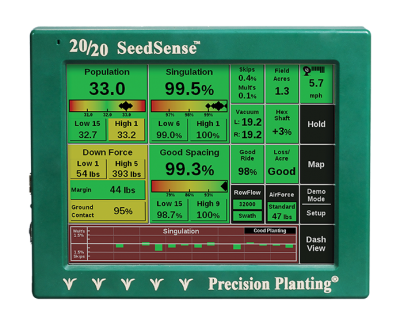YOU CAN MAKE A REAL DIFFERENCE DURING PLANTING IF YOU CAN PAY ATTENTION TO YOUR PLANTER:
20/20 SEEDSENSE MAKES IT HAPPEN.
With its color-coded, touchscreen display, you’ll spot any errors in down force, spacing and singulation immediately. You’ll zero in on the source. You’ll check it out. You’ll fix it. And you’ll move on, confident that you’re doing everything you can to plant profitably.
More precise than any other monitor, 20/20 SeedSense tells you what you need to know about population, skips, doubles, speed, row unit ride, down force and ground contact. It enables you to seed precisely, maintain depth, avoid compaction and troubleshoot mechanical problems.
20/20 SeedSense is easy to use, too. The main screen summarizes everything. The most important metrics are the largest. Green means go, yellow means caution, red means stop and fix whatever’s wrong. Just tap the screen and you’ll see row-by-row details, so you know where to look.
Singulation:
See the percentage of skips and multiples for the entire planter and each individual row. 95% singulation isn’t good enough.
Example: If a meter would have 1 skip or 1 multiple every 1000 seeds, that would equal a 0.1% dock in its singulation. So, if the meter had a combination of 15 skips and 10 multiples in 1000 seeds, its singulation would be at 97.5%.
Recommended Singulation for Specific Meters:
Vacuum Meters: 99.5% and above
Finger Pickup Meters: 98.5% and above
Pressure Meters: 98.5% and above
Down Force:
Watch ground contact to be sure you’re planting at full depth and monitor excess weight that leads to compaction — which leads to lost potential.
Good Spacing:
This is the percentage of seed spaced within the limits you set. Picket row fence, here you come.
Hex Shaft:
Is your ground drive transmission slipping? One glance tells you.
Loss / Acre:
See relative yield loss from the combined errors. If it says “Good”, you’re good.
Good Ride:
Row Unit Ride reports bounce & vibration of the row unit, letting you know if you need to slow down.



